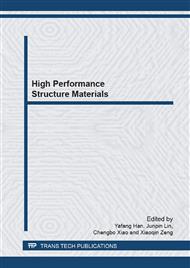p.636
p.641
p.647
p.654
p.659
p.665
p.672
p.678
p.684
Influence of Ageing Treatments on Stress Rupture Properties of Ni3Al-Base Single-Crystal Alloy IC21 at 850°C
Abstract:
The influence of three different ageing treatments (R1:1100/2h,air cooling+870/32h,air cooling, R2: 870/32h,air cooling and R3: 1060/2h,air cooling+870/32h,air cooling) on stress rupture properties of Ni3Al-base single-crystal alloy IC21 was investigated. The results indicate that ageing heat treatments have obvious effects on stress rupture properties of IC21 at 850/500Mpa. After R3 ageing treatment, IC21 alloy presents the longest rupture life and the smallest ellipticity and elongation compared to those after the other two ageing treatments. Microstructure examination shows that the mean size of γ precipitate is about 0.44μm after R3 ageing heat treatment (1060/2h, ac + 870/32h, ac). Transmission electron microscope (TEM) study on the rupture samples illustrates that after R1 and R2 ageing heat treatments, the density of stacking faults increases and the length is larger compared to that after R3 heat treatment. Meanwhile the shearings of γ precipitates are more severe. The appropriate γ phase size and γ channel width after R3 treatment promote homogenous deformation by <110>{111} slip in the matrix, and facilitate the formation of finer dislocation networks on the γ/γ interface, which can restrain the shearing of γ phase by dislocations.
Info:
Periodical:
Pages:
659-664
Citation:
Online since:
February 2013
Authors:
Keywords:
Price:
Сopyright:
© 2013 Trans Tech Publications Ltd. All Rights Reserved
Share:
Citation:


